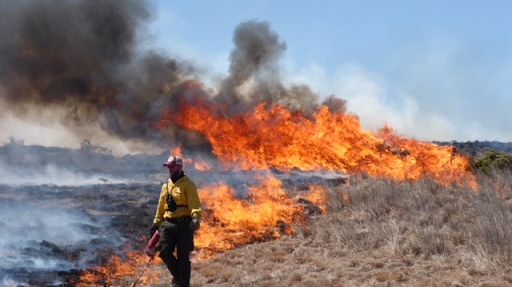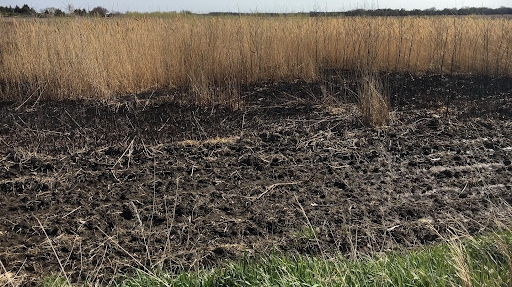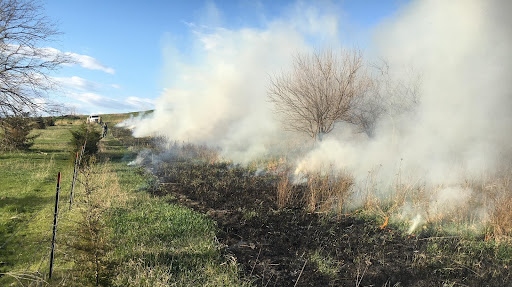Where are the monarchs now?
Fall migration is in full swing! Eastern migratory monarchs are beginning to arrive in Mexico. Texas is a migration hotspot, and reports are picking up in the Southeast and along the Gulf Coast. Western monarch activity is also ramping up, and some monarchs have reached overwintering sites in California. Learn more at Journey North.

Prescribed fire caution: If you are not experienced with prescribed fire, please contact your fire department before getting started. There are often permits needed to conduct a prescribed burn and a burn plan may be required to receive a permit.
If prescribed fire is in your habitat management toolbox, there are actions you should take in the fall to prepare for spring burns, including installing firebreaks. Prescribed fire is one of the best habitat management practices for maintaining high quality pollinator habitat. Deploying a safe and effective prescribed burn takes planning and preparation.
Farmers for Monarchs spoke with Brian Teeter, Nebraska prescribed fire coordinator at Pheasants Forever, about utilizing prescribed fire, including preparing firebreaks in the fall in anticipation of doing a prescribed burn in the spring.
Most ecosystems were born through fire. Burning promotes better wildflower diversity by reducing thatch, setting back grass succession that can choke out wildflowers, and is an effective tool for invasive tree control.
“Most landscapes in the country and most pollinators are adapted to fire because they evolved with fire,” said Teeter.
Permanent features like rivers, creeks, ponds, and roads can be used as firebreaks. However, Teeter advises that landowners should identify and remove any wood or debris that could catch fire. Additionally, using roads as firebreak requires taking into consideration traffic and any other road use.
“If you don’t have permanent features, we have to create our own firebreaks,” said Teeter.
There are several temporary firebreaks that farmers and land managers can create, including:
- Bare mineral soil
- Mowed areas
- Vegetated “green” firebreaks
- Crops that are green during burn season
- Burned areas, or black lines
A common rule when creating a firebreak is that it should be at least twice as wide as the average height of the adjacent ground cover. However, Teeter recommends that the firebreak actually be at least 10 times as wide. Doing so will greatly reduce the possibility of the fire jumping the break. This rule is particularly important when utilizing mowed firebreaks, which are among the most popular firebreaks used by farmers. To create this firebreak, the farmer mows the land to reduce the size of the vegetation, effectively reducing the amount of standing fuel. If you have the ability, an even better option to consider is haying and baling your firebreaks to more effectively reduce the thatch layer that can be created by just mowing.
Installing your firebreak in the fall is the most effective way to eliminate fuel buildup on the fireline and prevent the fire jumping the break into the surrounding landscape.
Another popular firebreak is the bare mineral soil approach, which might include something like a rototilled firebreak. This is created by mowing a wide section of land and then rototilling part of that strip to expose bare soil. A disked firebreak would create the same effect.
“With any kind of rototilled or disked firebreak, the biggest thing is to make sure you get down to bare mineral soil so there’s no vegetation on top,” said Teeter. “If you leave any residual material on top of it, it could creep across that line and potentially jump the firebreak.”

Another option is a vegetated or green firebreak, which utilizes green vegetation on the ground to create the firebreak. This would be part of your initial design of your habitat. Firebreaks composed of multiple clover species can also provide benefits to pollinators and other wildlife throughout the year. Green firebreaks are good options as long as there is no residual thatch on the ground. Teeter cautions that it is important to closely monitor fires when using a green firebreak because it is used to slow down, not stop a fire.

Some land managers will utilize blackline firebreaks near areas that may have recently experienced a wildfire as the ground is already burned. This is an advanced technique and blackline firebreaks should be utilized by experienced fire crews.
Please watch the interview included above for more information on firebreaks and when to use different techniques. Farmers interested in learning more about firebreaks can also access the Nebraska Pheasants Forever YouTube channel, which has several videos about burn plan writing, fire weather forecasting, and other topics related to conducting prescribed burns. You can also call the Farmers for Monarchs Pollinator Habitat Help Desk at (337) 422-4828 or (337) HABITAT for assistance.
Conservation Reserve Program Reminders:
Continuous CRP Signup is ongoing. General CRP sign-up is expected to be announced in January.
Producers interested in enrolling in the Conservation Reserve Program should contact the Farm Service Agency office at their local USDA Service Center.
